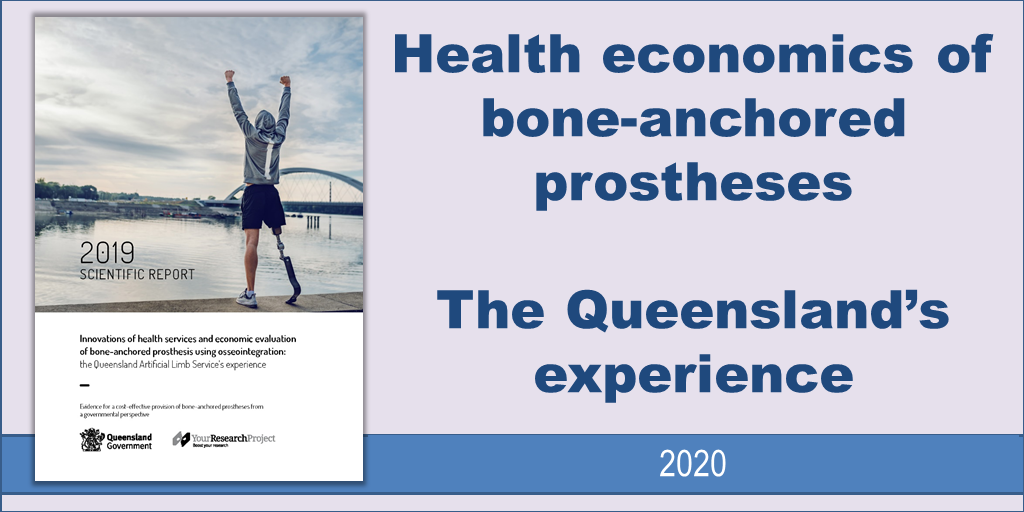https://eprints.qut.edu.au/200097/1/2019_Scientitic_Report_QALS.pdf
Frossard L. Innovations of health services and economic evaluation of bone-anchored prosthesis using osseointegration: the Queensland Artificial Limb Service’s experience- -2029 Scientific Report. Ed: YourResearchProject. 2020. ISBN: 978-0-646-81742-2. pp 18
The design of artificial limbs for persons with an amputation has continuously improved over the last decade. Nonetheless, there is still a large portion of individuals who are non-prosthetic users or facing substantial challenges when using a prosthesis. The conventional way to attach a prosthesis to the body is to use a plastic shell, called a socket, enveloping the residual limb. Unfortunately, this prosthetic attachment presents several shortcomings, mainly due to the friction within the socket causing regular damage to the skin. Altogether, these issues limit mobility and ultimately reduce significantly the quality of life of most prosthetic users. Most of these functional issues can be overcome by ground-breaking surgical procedures. A rod of biocompatible material, called osseointegrated fixation, can be inserted into the residual bone such as the femur or tibia and enable external attachment of a prosthesis. These bone-anchored prostheses present major clinical and prosthetic benefits with acceptable risks of infection, leading to a significant improvement in quality of life, particularly for young, active, and nonvascular individuals with above-the knee amputation. Benefits and opportunities for bone-anchored prostheses have been well echoed in social media worldwide generating an unprecedented high demand from groups of interests. Consequently, policy decision makers including health care managers are under substantial pressure to support the provision of bone-anchored prostheses, while responsibly allocating scarce resources within health care systems. In principle, bone-anchored prostheses could reduce some prosthetic and medical financial burdens for health service administrators by reducing the treatment of skin-socket interface problems over a user’s lifespan. However, little evidence is currently available to support this claim. Consequently, policy decision makers are left facing a series of challenges while addressing burning questions: Is the fair and equitable provision of bone-anchored prostheses required to have a specific procedure? What are the actual costs of the provision of bone-anchored prostheses? What is the cost-effectiveness of bone-anchored prostheses compared to conventional socket-suspended prostheses? In 2011, the Queensland Artificial Limb Ser vice (QALS), an Australian State Government public health organization initiated a research project to address these issues and provide strong evidence supporting the provision of bone-anchored prostheses. The purpose of this report is to share the knowledge gained by QALS during this project and to present subsequent health services innovations in the design of the policy, the assessment of the actual costs and production of cost-effectiveness associated with the provision of bone-anchored prostheses. The outcomes of this first economic evaluation from an Australian State Government public health prosthetic care and funding scheme’s perspective, indicates that the provision of bone-anchored prostheses can be supported by fair, equitable and affordable policy while being cost-effective. Thereby indicating, the new attachment relying on osseointegrated fixation is an acceptable alternative to conventional intervention at least from a public health prosthetic care and funding perspective. The experience reported here provides a working template for the development of economic evaluations to stakeholders responsible for policies around the care of individuals fitted with bone-anchored prostheses worldwide. We are thrilled to share with you some of the most valuable lessons we have learnt during the course of this scientific journey. A wealth of further in-depth information can be found the several scientific articles we have already published in top-ranked journals. We hope this report is both enjoyable and informative and ultimately facilitate a rapid translation of this evidence into practice that, altogether will ultimately improve reliability of many healthcare organizations in increasing quality of life of individuals leaving with the artificial limbs.

